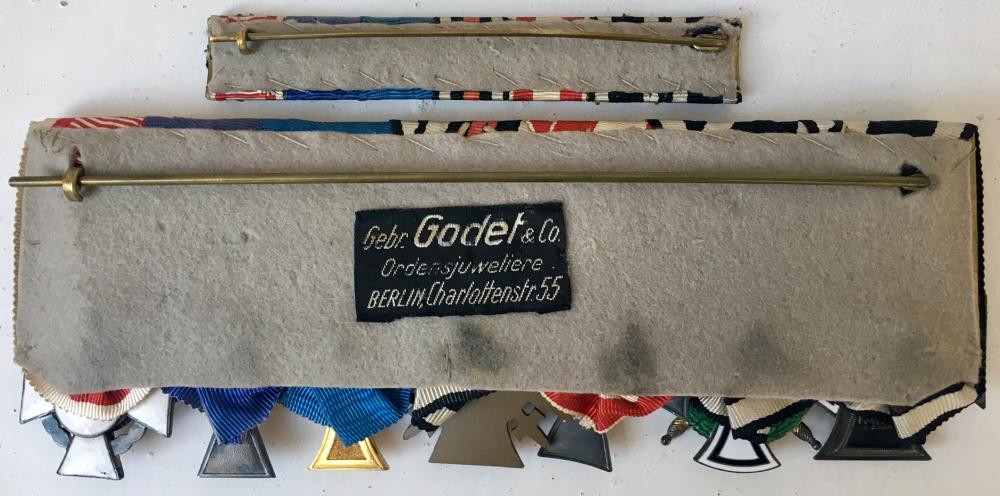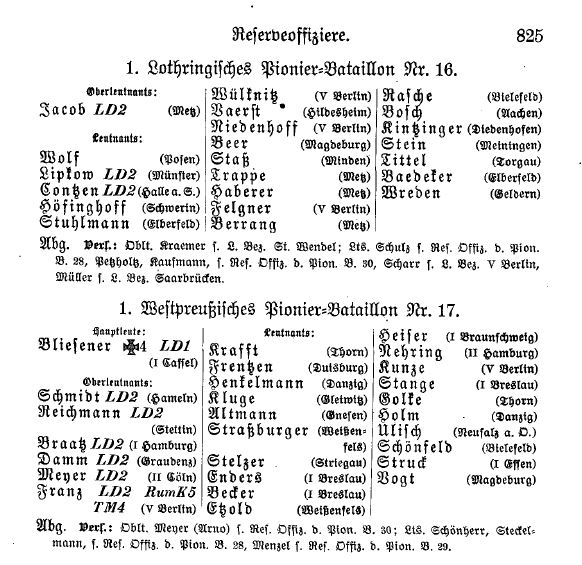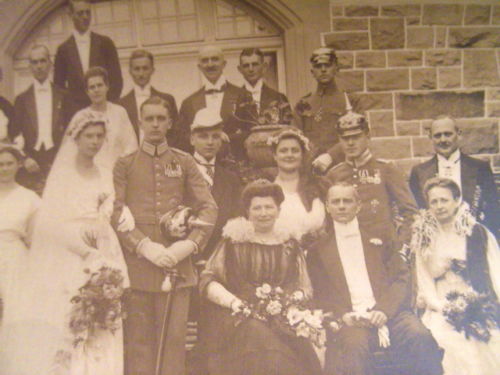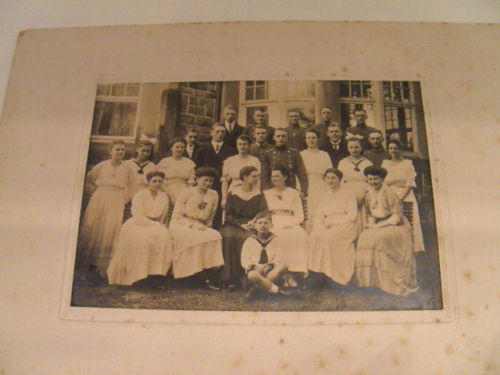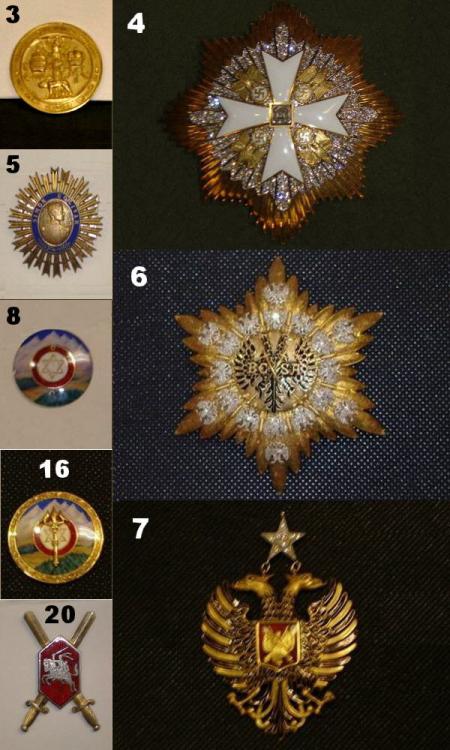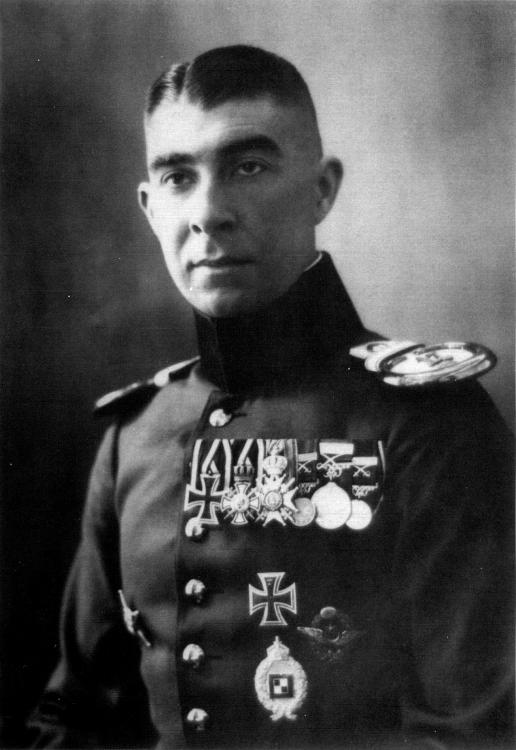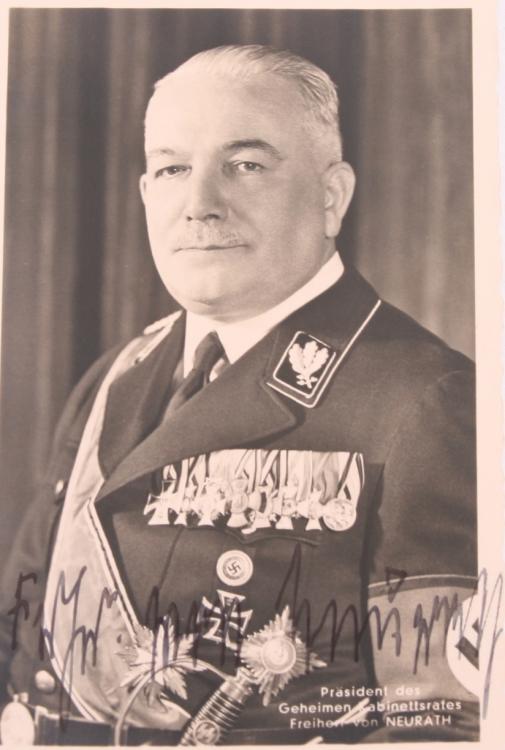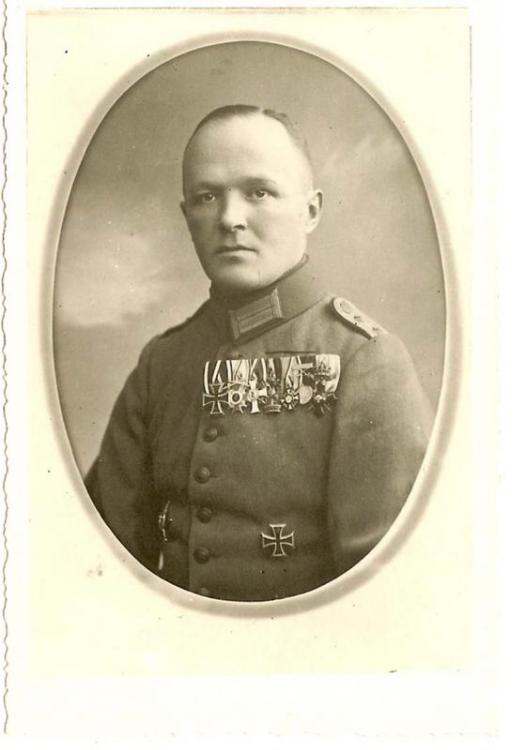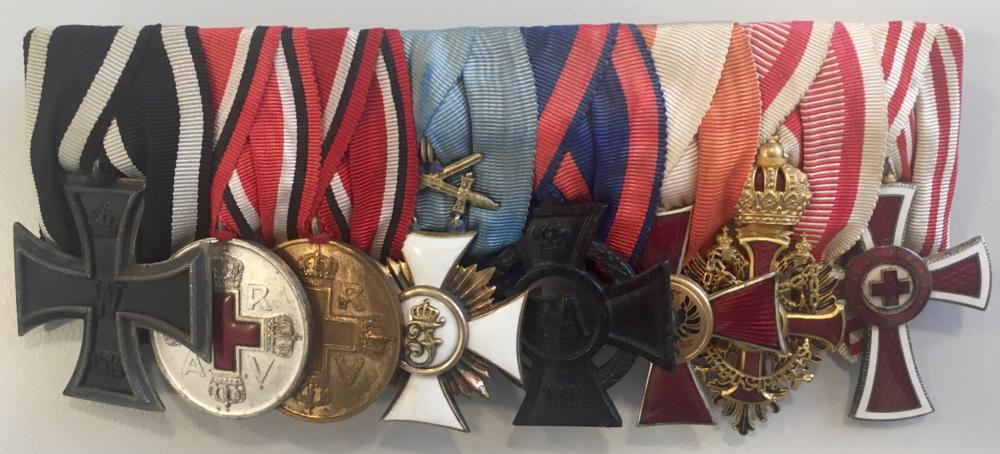-
Posts
2,868 -
Joined
-
Last visited
-
Days Won
20
Content Type
Profiles
Forums
Blogs
Gallery
Events
Store
Everything posted by Claudio
-
IMHO the EK2 is original, very likely like Dansson said, a Deumer piece, produced in the late 20ies/early 30ies. These sometimes you can find in pretty pristine conditions. I got a group of a officer and WWI veteran that had 2 EK1 1914... one was heavily worn on the field and the other one it was mint like the one you have on this bar. I don't like the BMVK1X either... these are easily upgraded by skilled collectors/dealers who have professional skills in gilding process and also in enamel repairs (I know a Bavarian collector/dealer who did it...). I would stick with textbook BMVK1, early types, 3 pieces medallion with gold L cyphers. Not all the Bavarian BMVK producers, produced the 1st class cross for instance...
-
Hi Laurentius, Thanks for showing your medal bar and welcome to this very informative and interesting forum. First of all it's quite impossible to say if this bar was really put together by a Godet bar: for sure the color of the backing (Godet used red before 1914, but a bit brighter tone of red and there always was a label with his name on such bars), the needle-catch system on the back, the fact that the EK2 1914 is not a Godet piece, are all indicators that probably this is not a Godet's bar. Furthermore the fabric on the back seems to me to be restored in a later period, but to be sure you need to put it on UV-light and check if the thread used is not post WWII. Your bar is nevertheless a nice one... enjoy it! ;-) ciao, Claudio Majors d. R. im Pio-Bat 17 Adolf Bliesener (* Duisburg 27.08.1868) Dear forumites, My latest new entry... Godet 100% also the Feldschnalle.... Orden & Ehrenzeichen auf der Schnalle: Preußen, Eisernes Kreuz 2. Klasse 1914 am Kämpferband (OEK 1909), E gs/S emailliert; Preußen, Kgl. Hausorden von Hohenzollern, RK m. Schwertern (OEK 1789), Sv; Hamburg, Hanseatenkreuz (OEK 688), E vs Ku; Deutsches Reich 1933-45, Ehrenkreuz für Frontkämpfer (OEK 3803/1); Preußen, Kronen-Orden 4. Klasse (OEK 1762), Br vg teils E; Preußen, Landwehr-Dienstauszeichnung 1. Klasse f. 20 Dienstjahre, nur für Offiziere (OEK 1977), S/G; Österreich Kaiserreich, Militärverdienstkreuz 3. Kl. am Tapferkeitsband Laufbahn: Am 27.08.1868 in Duisburg geboren. 20.09.1890: Sec.Lt. in der 2./Pi.Btl.17 Stettin RL 99: Leutnant d.R. Bliesener beim Pi.Btl.17 (gemeldet beim Bez.Kdo. IV Berlin) 15.06.1899: Oberleutnant d.R. Bliesener beim Pi.Btl.17 (gemeldet beim Bez.Kdo. IV Berlin) RL 04: Oberleutnant d.R. Bliesener beim 1.westpreußischen Pi.Btl.17 (gemeldet beim Bez.Kdo. IV Berlin), Ldw.DA 2.Kl. 17.11.1906, RL 14: Hauptmann d.R. Bliesener beim 1.westpreußischen Pi.Btl.17 (gemeldet beim Bez.Kdo. I Cassel), Kronenorden 4.Kl., Ldw.-DA 1.Kl. 18.06.1915: Major d.R. Adolf Bliesener war Kdr. des (Gas) Pionier-Btls. 36. Nach dem Krieg war er Branddirektor in Kassel.
-
Dear Forumites, Some nice additional info on the officer, given to me by a still living descendant who lives in Germany: 145. Ravan Kurt L.W.S. (1897-1968) 2.3.: 1., Ferdinand-Zweig; 1. Ravan-Unterzweig: XXI. Generation 145. (141.a) Ravan Kurt Leopold Max Sigmund, geb. in Karlsruhe am 23.03.1897, gest. in Freiburg i.Br. am 26.01.1968 (begr. Edb.[ii]), Mitbesitzer zu Sulzfeld, Major, Industrie-Kaufmann verheiratet in Egglingen (Baden), am 20.09.1920 mit Irmgard v. Lewinski, geb. in Pendenried b. Starnberg am 19.07.1900, gest. in Freiburg am 01.12.1970, begr. Ebd., T. d. Kgl. preuß. Majors d. Res. a.D. Kurt v. L. (1897-1942) und d. Johanna (Jenny) Freiin v. Aufseß (1876-1961). Al. 145. v. Lewinski Kinder: Friedrich, geb. in Ettlingen am 06.10.1921, Industriekaufm.; verheiratet mit Annemarie Wilke 2 Töchter, 1 Sohn. Fam. Nr. 146 Irmela Emmy Jenny, geb. in Freiburg 21.03.1923, gest. in Schwetzingen 07.02.1987, beigesetzt Sulzfeld[iii], lebte 1950-1965 bei den Eltern in Freiburg, war dann Stiftsdame des Kreichgauer Adeligen Damenstiftes. Von ihr stammt die Idee der Burgschenke. Berthold, geb. in Essen 24.11.19126, Großhandelskaufm., verheiratet mit Ingeborg v.Ondarza, 2 Söhne Fam. Nr. 147 Adelheit Lisbeth Irmgard, geb. in Essen 16.08.1928, verheiratet in Freiburg i.Br. am 29.12.1953 mit Heinz v. Sigriz, geb. in München 10.01.1928, gest. in Miesbach (OBay.) am 25.07.1996, Ing. Kinder: Nikolaus v. S., *Bad Tölz 14.12.1954 Wolfgang v. S., * Neuß 24.02.1956 Angelika v. S., * Neuß 22.08.1957 Ravan K.L.M.S. war der Sohn des Kgl. Preuss. Hauptmanns und Ghzgl. Bad. Hofmarschalls Sigmund II. A.F. Frhr. G.v.R. (1870-1951, Fam. Nr. 141) und d. Emily v. Bohlen und Halbach (1874-1939). 1914 wurde er Fahnenjunker im 1. Bad. Leib.Gren.Regt. 109; 1915 Leutnant; 1920 Abschied als Oberleutnant (GLA 456/3682), 1937 reaktiviert; 1920-1930 nach chem.-techn. Studium an d. TH. Karlsruhe: Besuch von Handelskursen und d. Obstbauschule Geisenheim. Als Betriebsleiter, später Prokurist, in versch. Betrieben der Holzindustrie tätig. 1926-28 Wohnung in Essen; 1930-1939 in d. chem. Industrie in Bochum, zuletzt Prokurist. Wohnung in Essen; 1939 Zug- u. Komp.Führer im II. Ers.Batl. Gren.Regt. 39, Mülheim, Ruhr; 1939-1940 Komp.Führer 9./Gren.Regt. 257; Hauptmann d.Res. (01.05.1940); 1940-1941 im Stab d. 83. Inf.Div. (Ordon.Offz. O3 und 1c), dann d. 99.leicht.Inf.Div. (IIa); 1941-1942 im Stab 7. Geb.Div. (IIa), dann Gen.Kommando LIX. AK (IIb); Major d.Res. 1942-1944 im Stab des LIX. AK als Adjudant, Führerreserve OKH/ D.r.W. Kdo. IV. 1944-1945 Wehrmachts-Streifen-Lehr-Abt.: englische Kriegsgefangenschaft; 1945-1946 Angestellter in der Industrie (Fa. Kohlenwertstoff AG, in Bochum); 1947-1948 Mitarbeiter im Göler’schen Weinbaubetrieb zu Sulzfeld (Wohnung in Amalienhof), Bevollmächtigter s. Vaters Sigmund, in den Mit-Eingtümer-versammlungen und Vertragsverhandlungen z. Bildung der „Vierer-Gruppe“ (Vertrag v. 07.11.1947) 1949-1962 in Verkauf u. Beratung d. Rhrstickstoff AG, Bochum, für Baden-Württ. Wohnte seit dem Tod des Vaters (1951) in dessen Haus in Freiburg (Seminarstrasse 16, verkauft Herbst 1970) und war 1951-1968, gemeinsam mit Albrecht G.v.R. (1878-1966), verantwortlich für das Frhr. V. Göler’sche Rentamt in Sulzfeld. Orden: EK 1914 II. Klasse (1915) Ghzgtm. Baden, Zähringer Löwen, RK 2. Kl. m. X (1916 durch d. Grossherzog) EK 1914 I. Klasse (1917, durch den Deutschen Kronprinzen!). Numerische Reihung: Ravan K.L. (hier Nr. 145) müsste als Nr. 142 direkt seinem Vater Sigmund (141) folgen, und Egon (hier Nr. 142) als Nr. 157, erst nach Berchtold (hier Nr. 147) und dessen Söhnen. Die Reihung hier folgt der Übersichts-Stammtafel des Göler-Sonderdruckers von 1979. [ii] Sein und seiner Eltern gemeinsamer Grabstein kam am 14.11.1985von Freiburg auf den Sulzfelder Familien-Friedhof neben der Ev. Kirche. [iii] Irmela: Urnen-Beisetzung im neuen Familiengrab auf dem Neuen Sulzfelder Gemeindefriedhof.
-

Inquiry about Mussolinis awards
Claudio replied to Peter J's topic in State, Civil Awards & Decorations
http://www.iagiforum.info/viewtopic.php?t=11178 In the above mentioned link you will find some of Mussolini's orders that were confiscated during his escape attempt in April 45 to Switzerland. Now they are kept in a safe of the Banca d'Italia... ciao, C -

Constantin Freiherr von Neurath decorations
Claudio replied to Alexandre's topic in State, Civil Awards & Decorations
Hi everybody, Here you can see his medal bars in wearing... too me it looks like mounted by Godet. Beautiful bar! ciao, Claudio -
Thanks Andy! Thank you Glenn! Well... then the catalogue's description was not correct. If it's him, he did write also a couple of books about WWI, like: Warum haben wir die Schlacht an der Marne verloren? https://www.zvab.com/servlet/BookDetailsPL?bi=20338671885&searchurl=hl%3Don%26sortby%3D20%26an%3DROHRSCHEIDT%2C%2BWALTER%2BV%2B Unsere Baltikum-Kämpfer: die Ereignisse im Baltikum 1918 und 1919 https://books.google.ch/books/about/Unsere_Baltikum_Kämpfer.html?id=1I3JMgEACAAJ&redir_esc=y C
-
mmmh... interesting... so in that case this bar has nothing to do with Wallenberg... I'm wondering where Thies did get this name's attribution from... The order of the first 4 medals is Prussian... I'm not convinced that this bar belonged to a citizen of Württemberg, but judging from the many "foreign orders" in the end of the bar, it makes sense that the wearer could have been a War Ministry officer or "im Generalstab"... C
-
Dear forumites, I just purchased the bar of the above mentioned General, or I do believe it was. So was also described on Thies' auction catalogue, as Württembergian General. However there are plus than one Wallenbergs who wore the rank of General. Nowever because of the Dates of birth and death, I think it can only be Walter (*26.06.1857 - † 05.02.1945), 1914 - Oberst und Bezirkskommandeur Landwehrbezirk I Oldenburg. Char. Gen.Maj: 26.1.20. Strange that this General doesn't have any Oldenburg orders or medals on the bar. Description of the orders and medals on the bar: Preußen, Eisernes Kreuz 2. Kl. am Kämpferband, 1914 (OEK 1909), E gs/S; Preußen, Roter Adler Orden Kreuz 4. Klasse (OEK 1704), S; Preußen, Preußen, DA-Kreuz für 25 Dienstjahre der Offiziere, 5. Form (OEK 1870/1), Br vg; Preußen, Kaiser Wilhelm I. Erinnerungsmedaille 1897 (OEK 1965/1), Br vg ; Bayern, Militär-Verdienstorden 4. Kl. mit Krone u. Schwertern (OEK 412), S/Sv emailliert Medaillon G; Sachsen Königreich, Albrechts-Orden RK 1. Kl. mit Schwertern mit (OEK 2206), Sv; Königreich Württemberg, Kronen-Orden Ritterkreuz mit Schwertern am Ring (OEK 2940), G emailliert; 3. Reich (1933-45), Ehrenkreuz für Frontkämpfer (OEK 3803/1); KuK Österreich-Ungarn, Orden der Eisernen Krone 3 Klasse mit KD, 3. Modell, Br vergoldet, BWK 608/ZK2 2066; KuK Österreich-Ungarn, Militärverdienstkreuz 3. Klasse, BWK1 240, 274, 283; KuK Österreich-Ungarn, Marianerkreuz des Deutschen Ritterordens Brustkreuz, BWK1 281/ZK2 4087; Osmanisches Reich, silberne kleine Liakat-Medaille mit Säbelbandspange, S. I thank you in advance for all additional information (career, medals, etc.) you might come up with. I really do appreciate your efforts. Thank you again. Best regards, Claudio I forgot to say that this General got the so-called Gallipoli star... a beautiful cased Godet's piece!
-
Dear forumites, I didn't show this other Godet's medal bar, yet. Attributed to Oberstabarzt a.D. Dr. Joseph Wirth (*1878 - † ? ),1914 Stabsarzt in the Prussian War cabinet/ministry, later with 4th Army. Description of the medals on the bar Preußen, Eisernes Kreuz 2. Kl. am Kämpferband, 1914 (OEK 1909), E gs/S; Preußen, Rote Kreuz Medaille 2. Kl., 1898, in Silber (OEK 1871), WM vs; Preußen, Rote Kreuz Medaille 3. Kl., 1898, in Bronze (OEK 1872), Br; Königreich Württemberg, Friedrichs-Orden RK 1. Kl. mit Schwertern (OEK 2981), Sv emailliert; Oldenburg, Friedrich-August Kreuz 2. Kl. am Band f.Kämpfer (OEK 1563); Lübeck, Hansatenkreuz (OEK 1265), S emailliert; KuK Österreich-Ungarn (bis 1918), Franz Joseph-Orden Ritterkreuz am Kriegsband (BWK1 668 / ZK2 2099), Gold; KuK Österreich-Ungarn (bis 1918), Ehrenzeichen vom Roten Kreuzes 2. Klasse ohne Kriegsdekoration, 1914 – 1923 (BWK1 344 / ZK2 2140), S emailliert. Maybe somebody out there can help me in finding more Details about Dr. Wirth's career or date and place of death. Thank you a lot in advance for your comments. ciao, Claudio
-
Dear forumites! My latest purchase fresh from Germany... maybe identifible? Here's the description of the orders and medals on the bar: Preußen, Eisernes Kreuz 2. Klasse am Kämpferband, 1914 (OEK 1909), E gs/; Preußen, Roter Adler Orden, Kreuz 4. Klasse (OEK 1704), S; Preußen, Landwehr-DA 2. Klasse 1913 (OEK 1979), ku ; Preußen, Kaiser Wilhelm I. Erinnerungsmedaille 1897 (OEK 1965/1), br vg ; Königreich Württemberg, Friedrichs-Orden RK 2. Kl. Mit Schwertern (OEK 2983), S Medaillon G; Bremen, Hansatenkreuz (OEK 651), ku vs emailliert; Weimarer Republik, Deutsche Ehrendenkmünze des Weltkriegs Königreich Sachsen, Albrechts-Orden RK 1. Klasse ohne Schwerter (OEK 2205), S/S vg Looking forward to read your inputs, thanks! ciao, Claudio
-
Hi Ben, Yes, these are veteran/reservist pre-1914 medals. These could have been privately purchased by the soldiers at the end of their service. The attaching on the reverse looks authentic to the period they have been issued. If you want to sell it, I would gladly make you a fair offer. ciao, Claudio


